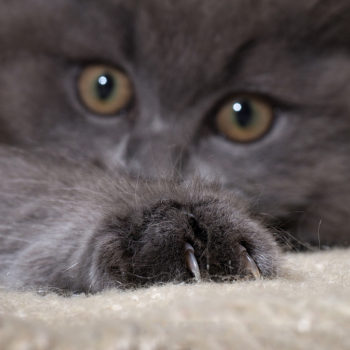Problems related to urinating and defecating outside the litter box and living with more than one cat are among the top reasons people surrender cats to a shelter. Is that worse for cats who have been declawed?
The average number of cats per cat-owning household is 2, indicating that multi-cat households are very common in the U.S. In a study funded by Maddie’s Fund and published in the September 15, 2016, issue of the Journal of the American Veterinary Medical Association, researchers looked at the connection between house-soiling and declawing (onychectomy ) in cats.
Among their findings was the fact that cats in multi-cat households who have been declawed are three times more likely to fail to use the litter box appropriately than those with intact claws:
(H)aving cats that had undergone onychectomy in a 3- to 5-cat household were all significant predictors of house soiling. Notably, having cats that had undergone onychectomy in a 3- to 5-cat household increased the risk of house soiling by more than 3-fold, indicating that the association between onychectomy and house soiling was influenced by the number of cats per household. Compare this finding with the results of the analysis in which onychectomy status was stratified by the number of cats per household, which showed that onychectomy status had no confounding effect on this association. Taken together, these results indicated that when there were 3 to 5 cats in a household that had also undergone onychectomy, there was a greater risk of house soiling in that household.
You can read the study abstract, as well as read (for subscribers) or purchase the full study, at the link below.
Gerard AF, Larson M, Baldwin CJ, Petersen C. Telephone survey to investigate relationships between onychectomy or onychectomy technique and house soiling in cats. J Am Vet Med Assoc. 2016 Sep 15;249(6):638-43. doi: 10.2460/javma.249.6.638.

